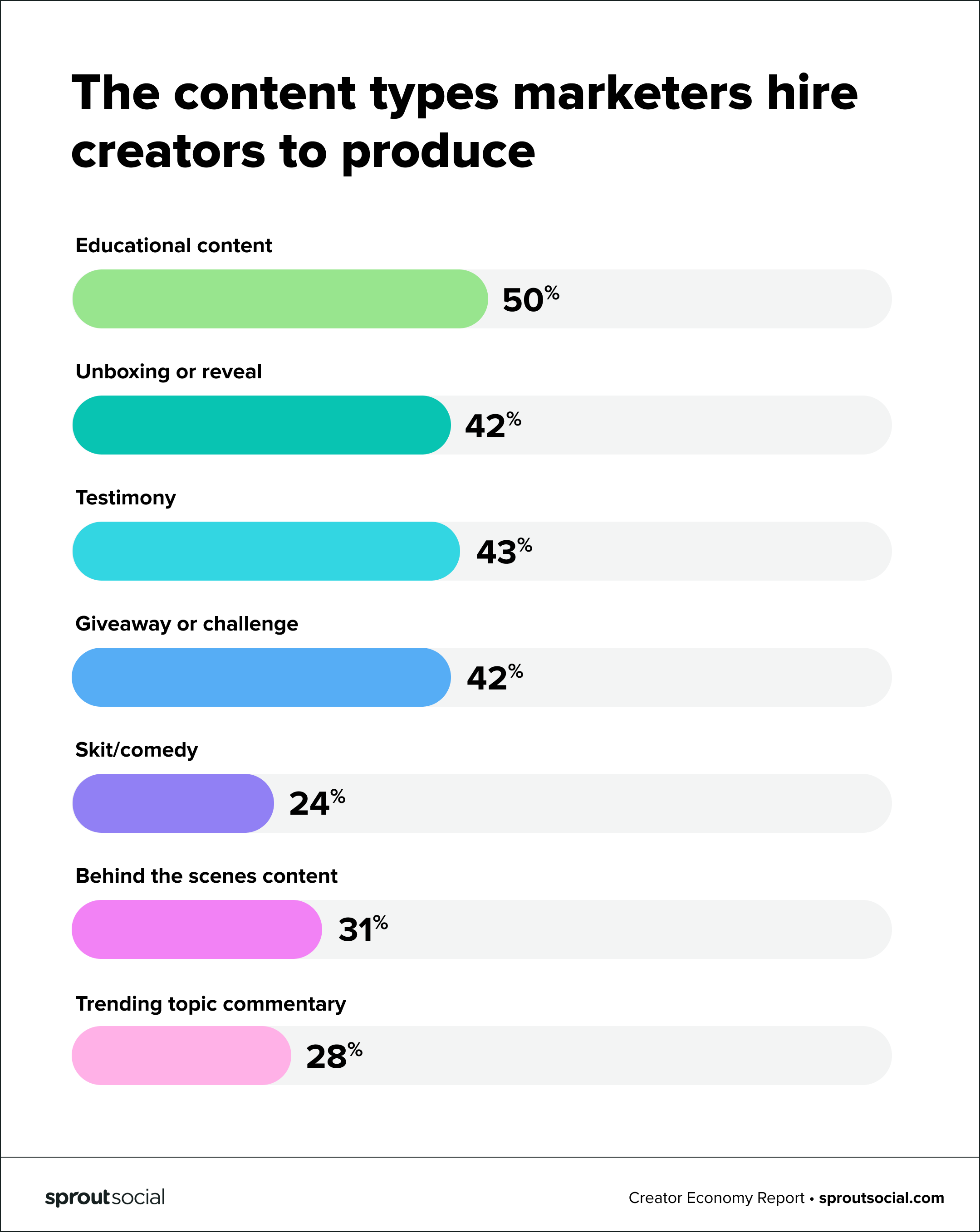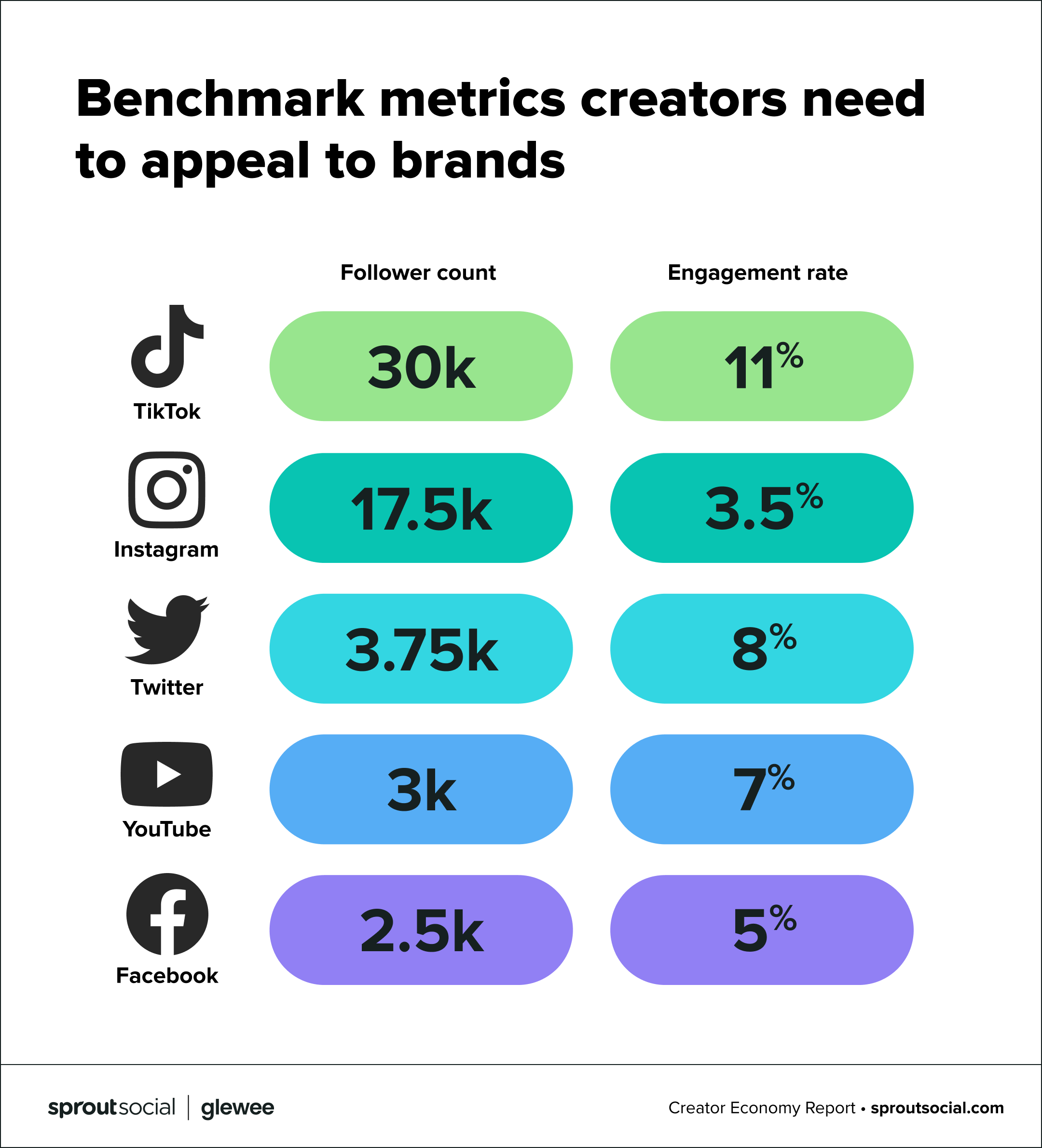The Creator Economy: Making Dollars and Sense Out of Social Partnerships
The social landscape is maturing and expanding. That’s exciting news, but many marketers are discovering that their tried and true tactics aren’t producing the same results. Enter the creator economy. With 50 million people identifying as creators, the content possibilities for brand partnerships are endless.
But with all of this opportunity, it can be hard to know where to start. Social teams that are used to working with creators on an ad hoc basis need to formalize their creator programs to keep up. To find out how brands are building their creator strategies, we asked over 500 US marketers about their relationship with the creator economy—from their goals and challenges with creator marketing, to which platforms and content types have the most creator potential.
What is the creator economy?
Successful creators don’t just churn out content, they inspire communities. They bring people together around shared interests, hobbies and identities. Those ready-built communities are extremely valuable and major brands are starting to recognize what they bring to the table.
Creator content is a prime way to reach your audience, whether you’re looking to nurture existing customers or attract new ones. Marketers rank generating engagement and reaching new audiences as their top two goals of creator marketing.

For example, The North Face’s collaboration with Jimmy Chin, a National Geographic photographer, underscores the perfect brand-creator partnership. Chin’s existing audience of over 110,000 followers and nature lovers is the perfect target for The North Face’s camping gear campaign.
"Camping" with @conrad_anker@thenorthfacepic.twitter.com/eUYOwZ76tC
— Jimmy Chin (@jimkchin) June 17, 2022
Dylan Mulvaney, a TikTok creator whose channel focuses on her transition into “girlhood,” partnered with the hyper-feminine brand, Kate Spade New York, for a series of paid posts. Dylan’s audience flocks to her videos for her unique take on what it means to be a girl and the joy of embracing your femininity. That perspective complements Kate Spade New York’s brand aesthetic of “optimistic femininity,” making for a powerful campaign match.
@dylanmulvaney And just like that, @kate spade new york has me ready for a cute girly summer #katespadenycabana#ad
The relationships creators have with their followers is authentic and genuine, and that authenticity rubs off on your brand. Creators have the power to reinforce your brand strategy by echoing your values and identity in a relatable way.
After years of filters and Photoshop, consumers are clamoring for the real. We’ve seen this across our research, with authenticity ranking as the second most important creator qualification by both marketers and consumers in the latest Sprout Social Index™.
By leaning on creators, 52% of marketers hope to strengthen their social community and 41% seek to promote their brand values. Creators can even help you change your audience’s perception of your brand, with 16% of respondents citing that as a goal for their creator strategy. The opportunity to reach your audience in a way that feels more organic can’t be overstated.
Where is the creator economy thriving?
Brands more than likely have to cede some control over to creators in order to capture the full benefits of these partnerships. While creator content is paid media, it’s not necessarily owned by the brand.
For maximum reach, 45% of brands have the creator post on their own account, compared with 27% that only post it on their pages. Hosting content on the creator’s account can give these campaigns a more organic feel with the added benefit of extending your reach. With the right research and sourcing, you can identify creators whose followers intersect with your target audience, but may be less familiar with your brand. A little less control over the content is well worth the benefits.

What should creators post?
When it comes to types of content, brands have choices. Different creators are masters of different content types—so it’s not a decision to be taken lightly. Brands report a healthy mix of what they look for when partnering with creators.

Educational content takes the top spot for marketers. It should be no surprise that brands are looking for creators to authentically show consumers how to use their product or service. If potential customers are coming in primed on how to use your product and the benefits of doing so, they’re more likely to be satisfied. Plus, who can resist the fun of learning something new?
@mikaylanogueira The best hyaluronic acid eye serum is from @loréalparis! The applicator is EVERYTHING! Available @target #LOréalParisPartner#Skincare#HAEyeSerum
Unboxing and reveal content is also extremely popular at 42%. Unboxing videos have an inherent authenticity to them, since the audience is discovering the product with the creator in real time, without any opportunity to polish up their first impressions. These clips are also a great way to show off your brand experience. If your packaging is one of the ways you surprise and delight customers, unboxing content can showcase the care you put into each order.
@maddie.east Obsessed with this bag 💗 @Coach #asmr#coach#coachoutlet#unboxing#haul#fyp
Nearly one-third of marketers want to win over audiences with behind the scenes content that demonstrates how real people use their products in everyday life. Seeing your product “in the wild” is a great way to persuade customers who might be on the fence.
@maui_thegoldenpup Tiktok made me buy it #lululemonbackpack#goldenretriever#petsoftiktok#fashiontiktok
Where should creators post?
Every platform lends itself to different audiences, creators and relationships between the two. As marketers craft their creator marketing strategies, they’re trying to meet their audience where they are.

It’s no surprise that Facebook, Instagram and TikTok reign supreme for creator partnerships. But marketers shouldn’t sleep on YouTube. More than half of consumers plan on spending serious time on the platform, but only 27% of marketers are putting money into YouTube creator collaborations.
What content format should you choose?
On Instagram and Facebook, story posts reign supreme. On TikTok, link in bios are extremely popular since they drive conversion, making them a prime candidate for affiliate marketing plays like #TikTokMadeMeBuyIt-style content. Brand shoutouts in YouTube videos are cost effective and work well, since they’re embedded into the content audiences are coming to see.

Curious how your peers approach creator content across platforms? Use the dropdown below to see how businesses of different sizes prioritize creator content formats.
Which content types do brands and creators collaborate on across platforms?
Use the dropdown menus to select your business size and which platform you want to publish on.
The numbers behind the creator economy
So how do you find the right creator and measure the impact they could have on your bottom line? To answer this question, we teamed up with Glewee, a platform that connects brands and creators to collaborate on content and campaigns.
In short, followers and engagement are great proxies to measure a creator’s potential impact on your brand. Glewee uncovered a minimum threshold for each platform, so you can make sure that your creator content reaches a sizable, engaged audience.

These benchmarks are far from one-size-fits-all, but they’re a great place to start evaluating your potential partners. An influencer with a smaller following might have a strong foothold with your audience, and what works on one platform might not work for another.
Deciphering content creator salary
The cost of creator content is heavily dependent on the compensation structure you land on. There are endless opportunities to mix and match post styles, metrics and campaign goals to find what works for you and the creators you partner with. But that can be overwhelming. There are more questions than answers about what constitutes equitable and fair pay for creator work. We partnered with Glewee to gather baselines for reference.

To get the best ROI from your creator partnerships, you need to think about your goals. Story posts are popular with marketers because of the cost, but the fleeting nature of the style might not generate the most long-term bang for your buck. If you’re looking to convert, links are your best friend, but they may cost more. It’s important to weigh pricing against the content’s potential longevity and goals of your campaign.
But that’s not all to take into account.
Sometimes, it makes more sense to use an alternative structure, like comped products or services or affiliate marketing, to meet your goals. Depending on your industry and niche, gifting premium products or services—such as luxury items or extravagant experiences—could be seen as fair compensation. If you’re casting a wide net, affiliate marketing might be more fitting. As you plan your approach, keep the creator’s interests in mind. What you’re asking of them and what they’re getting in return should be of equal value.

Getting your creator program up and running
Creator marketing has so many benefits. But it’s not without its challenges.
As expected, the top challenge that marketers face with creator marketing is budget. Most marketers (74%) plan to spend at least a quarter of their social media budget on partnering with a content creator over the next three to six months. With social teams reporting the need to prove ROI as one of their biggest challenges this year, it’s not surprising that justifying spend on less traditional tactics like creator content is difficult.

That’s not the only struggle. As social media teams are stretched thinner, finding resources to vet and manage creator relationships is easier said than done, even though 25% of marketers believe creator marketing can alleviate content creation pressure for their teams. For maximum impact, marketers need to source creators with a winning combination of audience relevancy and brand values alignment.
It takes a team to find that perfect creator.
Across businesses of all sizes, the social media and communications teams are taking that on internally. But as companies grow, they’re more likely to bring in others like legal and finance to help handle budgetary and contractual considerations. When it comes to enterprise companies (5,000 employees and above), 40% involve their legal team in the sourcing process from the beginning.

Sourcing creators doesn’t have to be a long process though. A one-to-two week time frame is standard for 49% of marketers, and 27% take three-to-four weeks.
But social moves quickly and creator campaigns are no exception.
Adding an extra few weeks for creator sourcing can have a serious impact on the effectiveness of your overall campaign—and add an entire month to your project timeline. This is where tapping into platform-specific features like TikTok’s Creator Marketplace, YouTube BrandConnect or Instagram’s creator marketplace, not to mention third-party services like Glewee, can help marketers scale their creator efforts.
Creating value with the creator economy
The data makes it clear—creator content isn’t going anywhere. Working with creators will only become more prevalent as social media platforms, consumer expectations and marketer strategies mature.
We’ve only seen brands’ earliest investments in the creator economy. It’s time for savvy brands to take what they’ve learned from their one-off creator experiences and formalize their process. Implementing best practices for how you approach creator partnerships will pay dividends for your brand awareness, engagement and bottom line.
Looking for more data to drive your social strategy? Check out the Sprout Social 2022 Index™, where we break down all the latest trends in social.
About the data
The data referenced was collected via online survey from 516 US marketers. Participants were recruited by Lucid between May 19-25, 2022. Selected participants were those responsible for their brand’s social strategy or worked at an agency responsible for another brand’s social strategy. Additionally, selected participants were marketers who had previously or are currently planning on working with content creators within a three to six month period. Relationships between variables collected were analyzed using parametric statistics for statistical significance.
Recommended for you
View all Recommended for you- Categories
Social media in Europe: 12 stats to inform your strategy
Published on July 15, 2024 Reading time 6 minutes - Categories
Post Performance Report: Brands turning IRL events into online engagement
Published on May 21, 2024 Reading time 6 minutes

